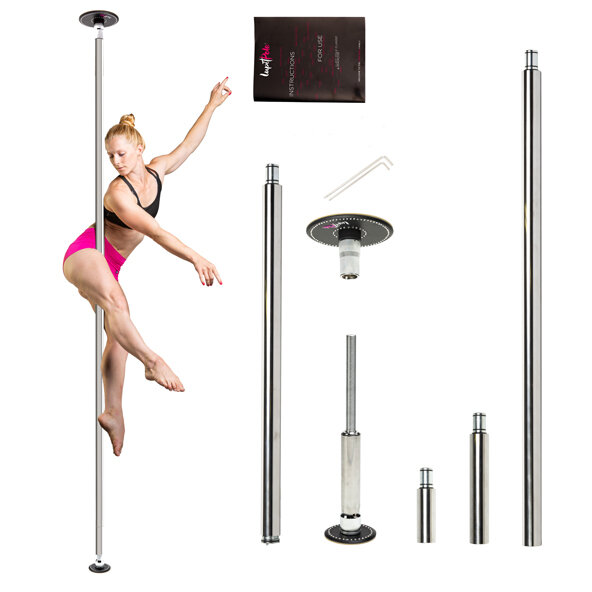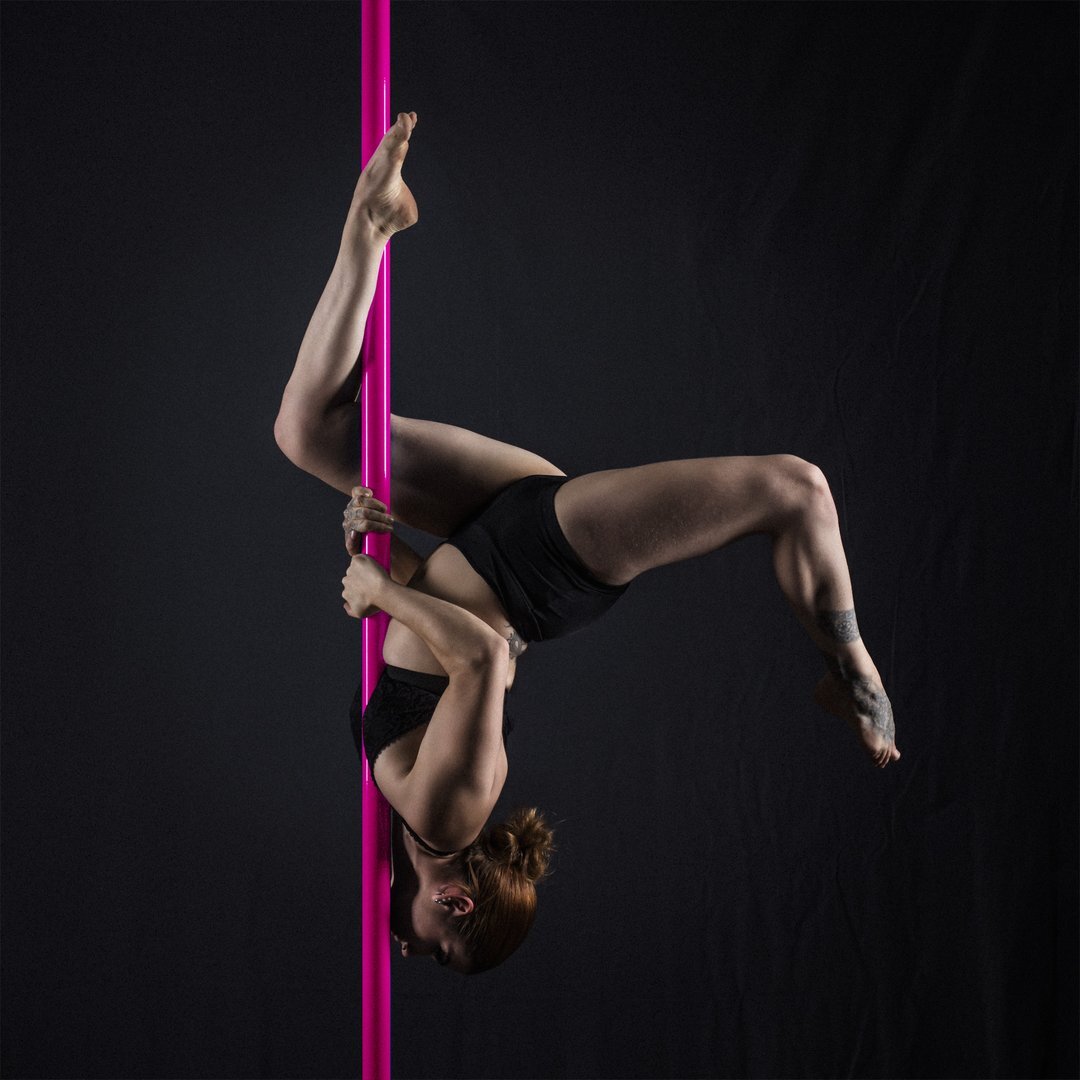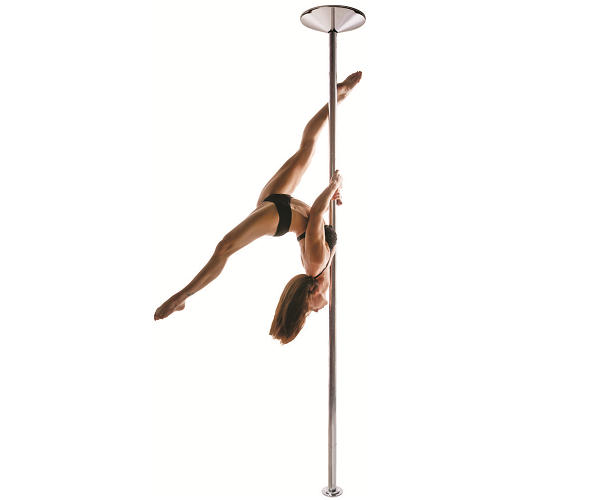Buying a Pole for Home Use
Originally written and posted December 14, 2016. Updated and re-posted January 2021. Latest updates regarding Canadian pole suppliers added February 2024.
Are you considering buying a pole to use at home? Not sure where to start? Here are some commonly asked questions and their answers to help you decide.
Above: Heather Poulin posing on a stage pole, outdoors. Photo by Alexa Baker Photography
First though, who am I and why should you take my advice on buying a pole? My name is Heather, and I’m the owner of Brass Butterflies Pole and Aerial Studio in Waterloo, Ontario, Canada. I started taking pole dancing lessons in 2010, became an instructor in 2011 and purchased my own studio at the end of 2012. I purchased my first pole for use at home after I had been taking lessons for just a few months. I wanted to be able to practice at home, in between my weekly classes. I did a lot of research at the time, and the first pole that I purchased for home use was an X-pole. When I became a studio owner, I became an authorized Dealer for X-pole and sold X-pole exclusively for almost 8 years. Unfortunately, in 2020, X-pole discontinued their Canadian Dealer program due to COVID-19 supply restrictions, so Brass Butterflies is no longer an X-pole authorized dealer. UPDATE February 27, 2024: X-pole closed their Canadian warehouse, a couple of years ago, however they have opened their online affiliate program to Canadian studios and Brass Butterflies is currently looking into becoming an affiliate.
This blog post in its original form dealt solely with X-pole. While I do still recommend X-pole as a reputable and experienced manufacturer of safe home poling equipment, after researching and trying some other company’s home pole products, I also highly recommend Lupit Pole for safety and quality. Brass Butterflies became a Lupit Pole Studio Affiliate in 2020. Use the link above and code BrassButterflies5 for a 10% discount.
Other companies that I do not have personal experience with but have been recommended as reputable suppliers in the pole community are Gaia Pole and Lil Minx.
Photo source https://lupitpoleusa.com/
Photo source https://www.fitbarpole.com/products/pole-rose
Frequently Asked Questions and Considerations When Buying a Pole For Home Use
Are the poles removable/portable?
Almost all reputable at home pole manufacturers offer a removable/portable line of poles that are installed using pressure. They have patented mechanisms that you twist to increase the upward/downward pressure when installing, which then gets locked/covered and is independent of the pole surface so that you don't have to worry about it "unscrewing" if you spin in a specific direction. Some of the cheaper, novelty poles have this issue. Some removable pole models disassemble into several pieces and extensions which makes them very height adjustable. Some are ordered as one solid piece so the range of heights you can use your pole in is more limited. Removable poles typically come with a carrying case and they are definitely removable and portable. Depending on model and material, the average weight range is between 15-20 kg. Again, depending on manufacturer and model, they can typically be assembled and installed by one person in about 15 - 20 minutes with minimal tools.
Photo source https://www.x-pole.ca/
What material should I choose?
There are several different materials available for poles. The most common in Canada are Brass and Chrome. Stainless Steel and Powder Coated are slightly less common but have been gaining in popularity in recent years. Other finishes that you can find home poles in are Titanium Gold (electronically coated finish exclusive to X-pole) and silicone.
Chrome - Standard grip. Industry standard for competitions and showcases. Students who are used to brass will generally find chrome "slippery" but will eventually get used to it. People with contact allergies to metals such as nickel may react to chrome depending on length of exposure and severity of allergy.
Brass - High grip. Common in studios (in Canada). More expensive.
Titanium Gold - Exclusive to X-pole. Electronically coated to enhance grip to somewhere between chrome and brass. Aesthetically looks more like brass (yellow/gold colour). Mid-priced. Coating will eventually wear off with extensive use to reveal chrome beneath.
Stainless Steel - Grip similar to chrome. Best for sensitive skin. Will not tarnish in humid climates.
Powder Coated - Painted surface similar to automotive paint or the paint on playground play structures. Also better for sensitive skin or those with metal allergies. Very high grip (could be too much for students learning spins on static poles).
Silicone covered - Maximum grip/cannot spin on static mode or slide down. Can be gripped while wearing clothing. Similar to Chinese Pole.
What size/circumference should I choose?
Poles can be purchased in different diameters. 45mm is the industry standard now, used for most competitions and showcases, especially in North America. Standards in studios will vary regionally. Thicker poles (48-50mm) will be more challenging for students when learning spins and tricks requiring hand grip, however they may make sitting and tricks that involve hanging from the legs easier/more comfortable. Skinnier poles (38-40mm) are the opposite. They are easier to grip with hands for the beginner but may make sitting and leg tricks more painful or harder to learn. This is why 45 mm seems to have been chosen as the "happy medium" standard for the industry. Students with larger hands/longer fingers or smaller than average hands, may want to opt for a larger or smaller pole diameter but I recommend sticking to 45mm for most students.
How much space do I need?
You should be able to swing your body out from your pole without danger of kicking a wall or furniture. A good rule of thumb is minimum 5.5' from a wall or solid object and at least 7.5' between two poles. If you are very tall/long limbed, you may want a bit more space.
How much height do I need?
The average residential ceiling height will range from 7.5 - 9’. Any shorter than 7.5’ will make learning challenging as even the most basic spins require the height of an arm extended straight overhead. You can learn and practice with standard 8’ ceilings, but 9-11’ is the sweet spot range that allows room for climbing and aerial inversions. Standard X-pole (Xpert, Pro or Sport) and Lupit G2 Home pole basic kits come with extension pieces to allow installation with ceiling heights ranging from 7.5 - 9'. Additional extensions can be purchased to extend poles up to 12' for brass or 14' for chrome. Anything higher than this will multi-piece removable poles have too much sway/give and could be dangerous. If you have ceilings that are higher than 14’, you will want to purchase a custom, one-piece studio grade pole and should contact your local studio or the manufacturer directly for help before ordering.
Spinning or static?
Most new generation home poles contain bearings which, when "unlocked" or set to spin mode, allow the pole itself to spin in place. Spin pole is an integral part of competition and showcasing, however it is not usually introduced to students in North America until they are beyond an introductory level. Spin pole, for the most part, is actually more difficult and requires more strength than static pole. However, investing in a pole that will eventually be able to be used in both static and spin mode is a good idea, even for a beginner, if they think they will eventually want to learn spin pole, so that they won't need to sell and upgrade their pole later, which may cost more in the long run.
Ceiling and Flooring Considerations
Will it damage/mark my ceiling/floor?
Because most standard home pole models are installed using pressure, you do not have to drill into the ceiling or floor. The dome or plate at the top and the foot of the pole have silicone pads that prevent slipping and marking. You can get permanent block mounts which would screw into the ceiling for added stability and security, however these are typically unnecessary for home use, unless you have vaulted ceilings. You will need a stud finder when installing your pole so you can centre the dome on one or two ceiling joists, depending on your ceiling construction. This is an important step to prevent uneven pressure from causing damage. If you have a "popcorn" stucco ceiling, the top dome/plate may leave a faint ring in the pattern of the stucco.
What if I have vaulted ceilings?
Both Lupit and X-pole sell special mounts for vaulted ceilings. These do have to be screwed into the ceiling.
What if my ceilings aren't finished?
You will likely need to affix a piece of plywood across your joists and mount your pole to that.
What if I have carpet in the area where I want to install my pole? What if I have a cement floor?
Removable poles can be installed on wall to wall carpet. You have to make sure to install tightly, and it will compress the carpet and leave a "dent" similar to if you placed a heavy piece of furniture on your carpet. You will want to consider that pole dancing often has you dragging toes or feet on the floor or landing on your knees so you'll need to be careful of carpet burn. The same thing if you have an unfinished cement floor; this could be very hard on your feet/knees.
WARNING. DO NOT place a loose mat or area rug under your pole. This compromises safety as the material could slip with lateral force, even if it's "non slip" material, and the base of your pole could "kick out".
Stage Poles
Another possible option for home use, other than a removable or a permanently mounted pole, is a stage pole. Stage poles are freestanding poles that have a weighted base to support them so they don’t tip. They are not attached to anything at the top. Stage poles provide ultimate portability for performers and photographers that want to set up in spaces where they can’t set up a removable pole due to ceiling limitations (or absence). This might be a good solution for pole students who can’t install a pole in their homes for various reasons. However, there are several downsides to stage poles that you should consider before deciding to purchase one for recreational use.
Stage poles typically require more height. The dance surface of the base will be raised anywhere form 2 - 12” and the standard kit for most stage poles require 10 - 10.5’ clearance. They can be used with shorter ceilings but you would have to purchase additional extension pieces to adapt them. They are not as stable as attached poles and can feel “wobbly”; you have to be very careful doing “power” moves (big spins and release moves that put serious lateral forces on the pole). They are very heavy and, although they are technically portable, they are not easy to move. They have to have heavy bases for stability. They are expensive. Compared to your average removable home pole, a stage pole will cost you, on average, twice as much. You’re looking at approximately $1,000 CAD to get a new, quality stage pole.
Jess and Jenya using our X-stage Lite at our outdoor urban pole photoshoot, used with permission. Image by Alexa Baker Photography.
Ready to Buy a Pole?
Brass Butterflies is a Lupit Pole studio affiliate. If you purchase from https://lupitpole.com/ use the code BrassButterflies5 at checkout to receive a 10% discount on your purchase.
Notes on Safety
Do I need a crash mat?
It's a good idea to have a crash mat if you will be practicing inversions or high climbs. It is also a good idea to always have a buddy nearby when you are poling. One who is trained to spot you properly is even better, but beware of untrained spotters. They could cause injury to you and themselves rather than preventing it.
You can buy crash mats specifically made for installing around the base of a pole from various sources. I bought my studio crash mats from a couple of different sources that are no longer available, however most pole manufacturers also sell crash mats.
Lupit Pole also sells crash mats. (use code BrassButterflies5 at checkout to get 10% discount)
What are the best/safest ways to learn if you pole at home and don't attend lessons at a studio?
Pole dancing is a sport/art similar to other forms of dance or gymnastics and is progressive in nature, meaning you need to learn foundational skills then layer progressively more difficult skills on top of these. It is really best learned from an expert who is experienced and trained in safety and proper teaching techniques. Being a good pole dancer does not make someone a good teacher. So, along these lines, if attending a reputable studio with experienced instructors is not an option available to you, it is best to use a reputable source for online video lessons.
Live Online Lessons: With the start of the COVID-19 pandemic, many more studios began offering live online lessons through ZOOM or similar platforms. The benefit of a live online class or private lesson is that you get real time feedback from a teacher who is able to watch you and provide tips and corrections on form. If you can’t be in person with an instructor, this is the next best thing and it’s worth paying for.
On Demand Online Lessons: For on demand videos, please resist the temptation to use random YouTube or Instagram videos to teach yourself on the pole. Watching these videos is great for inspiration and motivation. Absolutely follow your favourite pole stars and fellow students alike. However, you should use the same criteria for choosing online lessons as you would for choosing a studio. Usually, to get good quality, you will have to pay a subscription fee, but not necessarily. The rule of thumb usually is that you get what you pay for. Research the background, training and experience of the person or organization making the videos. Here are a few sources I've used in the past and know are reputable. This is not an exhaustive list.
Studio Veena http://studioveena.com
Tantra Tutorials http://www.tantratutorials.com/
Open Dance Academy https://www.opendance.academy/
Canadian Pole Fitness Association Online Academy https://canadianpolefitnessassociation.com/cpfa-online-academy/





